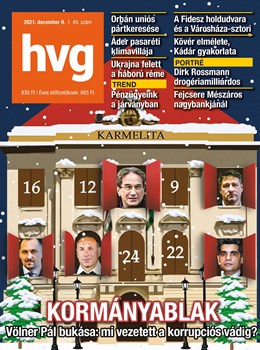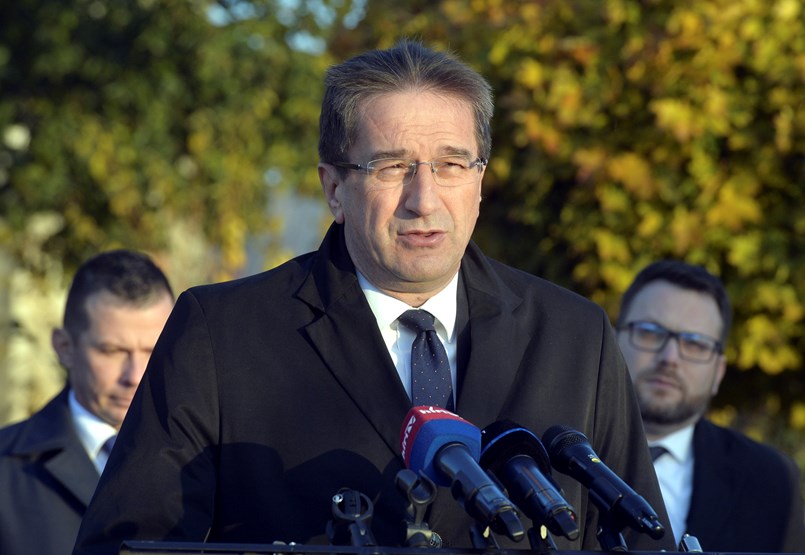[{“available”:true,”c_guid”:”41fa13a6-23e4-4d30-a077-10fc158d17b8″,”c_author”:”HVG360″,”category”:”360″,”description”:”Kovács Péter a Fidesz kongresszusán arról beszélt, még várnak a pártközpontra, hogy megtalálja a válaszokat a számukra kellemetlen kérdésekre, de ha ezek meglesznek, megnyerik a választást. Ceglédi Zoltán besegített, milyen témák merülhetnek fel kellemetlenként, és mik lehetnek a frappáns válaszok.”,”shortLead”:”Kovács Péter a Fidesz kongresszusán arról beszélt, még várnak a pártközpontra, hogy megtalálja a válaszokat a számukra…”,”id”:”20211208_Duma_Aktual_Fideszes_kerdesek”,”image”:”https://api.hvg.hu/Img/ffdb5e3a-e632-4abc-b367-3d9b3bb5573b/41fa13a6-23e4-4d30-a077-10fc158d17b8.jpg”,”index”:0,”item”:”179c3b84-2dea-4693-85f0-cc7314f34fb8″,”keywords”:null,”link”:”/360/20211208_Duma_Aktual_Fideszes_kerdesek”,”timestamp”:”2021. december. 08. 19:00″,”title”:”Duma Aktuál: Kellemetlen kérdések, jó válaszok fideszeseknek”,”trackingCode”:”RELATED”,”c_isbrandchannel”:false,”c_isbrandcontent”:false,”c_isbrandstory”:false,”c_isbrandcontentorbrandstory”:false,”c_isbranded”:false,”c_ishvg360article”:true,”c_partnername”:null,”c_partnerlogo”:”00000000-0000-0000-0000-000000000000″,”c_partnertag”:null},{“available”:true,”c_guid”:”ef251246-4ef6-4e23-b785-0bb78789d400″,”c_author”:”hvg.hu”,”category”:”tudomany”,”description”:”A mobilok feloldásának jelentős gyorsulását várja a Qualcomm attól az újdonságtól, ami a szakértők szerint rossz kezekben adatvédelmi rémálmot hozhat.”,”shortLead”:”A mobilok feloldásának jelentős gyorsulását várja a Qualcomm attól az újdonságtól, ami a szakértők szerint rossz…”,”id”:”20211208_android_telefon_kamera_feloldas_qualcomm_arcazonositas”,”image”:”https://api.hvg.hu/Img/ffdb5e3a-e632-4abc-b367-3d9b3bb5573b/ef251246-4ef6-4e23-b785-0bb78789d400.jpg”,”index”:0,”item”:”80aa0ac9-f5ec-4589-91d4-ce4a8ee20cf2″,”keywords”:null,”link”:”/tudomany/20211208_android_telefon_kamera_feloldas_qualcomm_arcazonositas”,”timestamp”:”2021. december. 08. 09:03″,”title”:”Az új androidos telefonok akkor is figyelni fogják az arcát, amikor hozzá sem ér a készülékhez”,”trackingCode”:”RELATED”,”c_isbrandchannel”:false,”c_isbrandcontent”:false,”c_isbrandstory”:false,”c_isbrandcontentorbrandstory”:false,”c_isbranded”:false,”c_ishvg360article”:false,”c_partnername”:null,”c_partnerlogo”:”00000000-0000-0000-0000-000000000000″,”c_partnertag”:null},{“available”:true,”c_guid”:”edead50b-a426-4e47-912e-c0255f5a5371″,”c_author”:”hvg.hu”,”category”:”tudomany”,”description”:”Az amerikai Cleveland Clinic kutatói több mint 1600 gyógyszer hatékonyságát vizsgálták át, és arra jutottak, hogy a szildenafil szedése jelentősen csökkentheti az Alzheimer-kór kialakulásának kockázatát.”,”shortLead”:”Az amerikai Cleveland Clinic kutatói több mint 1600 gyógyszer hatékonyságát vizsgálták át, és arra jutottak…”,”id”:”20211207_viagra_alzheimer_kor_kezelese”,”image”:”https://api.hvg.hu/Img/ffdb5e3a-e632-4abc-b367-3d9b3bb5573b/edead50b-a426-4e47-912e-c0255f5a5371.jpg”,”index”:0,”item”:”6f64ff26-7459-44e7-a8cf-fa796a661012″,”keywords”:null,”link”:”/tudomany/20211207_viagra_alzheimer_kor_kezelese”,”timestamp”:”2021. december. 07. 10:33″,”title”:”Kutatók állítják: a Viagra hatásos gyógyszer lehet az Alzheimer-kór ellen”,”trackingCode”:”RELATED”,”c_isbrandchannel”:false,”c_isbrandcontent”:false,”c_isbrandstory”:false,”c_isbrandcontentorbrandstory”:false,”c_isbranded”:false,”c_ishvg360article”:false,”c_partnername”:null,”c_partnerlogo”:”00000000-0000-0000-0000-000000000000″,”c_partnertag”:null},{“available”:true,”c_guid”:”852fa253-f86c-46ff-940d-b001585d9c1d”,”c_author”:”MTI”,”category”:”vilag”,”description”:”Az általános iskolákban pedig távolságtartási szabályokat léptetnek életbe. “,”shortLead”:”Az általános iskolákban pedig távolságtartási szabályokat léptetnek életbe. “,”id”:”20211207_francia_szigoritas_diszko”,”image”:”https://api.hvg.hu/Img/ffdb5e3a-e632-4abc-b367-3d9b3bb5573b/852fa253-f86c-46ff-940d-b001585d9c1d.jpg”,”index”:0,”item”:”b63f192b-2ef1-470c-ac05-70e726b4369a”,”keywords”:null,”link”:”/vilag/20211207_francia_szigoritas_diszko”,”timestamp”:”2021. december. 07. 07:55″,”title”:”Szigorítanak a franciák, egy hónapig tilos a diszkó”,”trackingCode”:”RELATED”,”c_isbrandchannel”:false,”c_isbrandcontent”:false,”c_isbrandstory”:false,”c_isbrandcontentorbrandstory”:false,”c_isbranded”:false,”c_ishvg360article”:false,”c_partnername”:null,”c_partnerlogo”:”00000000-0000-0000-0000-000000000000″,”c_partnertag”:null},{“available”:true,”c_guid”:”382e9540-195e-4637-9ffc-cbb0c088aed0″,”c_author”:”hvg.hu”,”category”:”itthon”,”description”:”Hétfőn 4311 új fertőzöttet diagnosztizáltak a fertőzéssel, 224 beteg hunyt el a koronavírus következtében. Lélegeztetőgépen 618-an vannak. “,”shortLead”:”Hétfőn 4311 új fertőzöttet diagnosztizáltak a fertőzéssel, 224 beteg hunyt el a koronavírus következtében…”,”id”:”20211207_Koronavirus”,”image”:”https://api.hvg.hu/Img/ffdb5e3a-e632-4abc-b367-3d9b3bb5573b/382e9540-195e-4637-9ffc-cbb0c088aed0.jpg”,”index”:0,”item”:”ba94bdf7-870a-45ca-874c-a578126dd490″,”keywords”:null,”link”:”/itthon/20211207_Koronavirus”,”timestamp”:”2021. december. 07. 08:59″,”title”:”Koronavírus: 4311 új beteg, 224-en hunytak el hétfőn”,”trackingCode”:”RELATED”,”c_isbrandchannel”:false,”c_isbrandcontent”:false,”c_isbrandstory”:false,”c_isbrandcontentorbrandstory”:false,”c_isbranded”:false,”c_ishvg360article”:false,”c_partnername”:null,”c_partnerlogo”:”00000000-0000-0000-0000-000000000000″,”c_partnertag”:null},{“available”:true,”c_guid”:”302d04aa-45ef-4f6b-9f47-15397db078f3″,”c_author”:”MTI / hvg.hu”,”category”:”kkv”,”description”:”A Nébih szerint radikális intézkedés kell a betegség terjedésének megakadályozásához.”,”shortLead”:”A Nébih szerint radikális intézkedés kell a betegség terjedésének megakadályozásához.”,”id”:”20211208_madarinfluenza_pecsenyekacsa_balmazujvaros”,”image”:”https://api.hvg.hu/Img/ffdb5e3a-e632-4abc-b367-3d9b3bb5573b/302d04aa-45ef-4f6b-9f47-15397db078f3.jpg”,”index”:0,”item”:”d3167cc9-cc93-47b3-8aff-f55767dc618b”,”keywords”:null,”link”:”/kkv/20211208_madarinfluenza_pecsenyekacsa_balmazujvaros”,”timestamp”:”2021. december. 08. 19:11″,”title”:”Madárinfluenza miatt leölnek 42 ezer pecsenyekacsát Balmazújvárosban”,”trackingCode”:”RELATED”,”c_isbrandchannel”:false,”c_isbrandcontent”:false,”c_isbrandstory”:false,”c_isbrandcontentorbrandstory”:false,”c_isbranded”:false,”c_ishvg360article”:false,”c_partnername”:null,”c_partnerlogo”:”00000000-0000-0000-0000-000000000000″,”c_partnertag”:null},{“available”:true,”c_guid”:”e0947f22-bcbf-4e0e-b2d1-53f17fb5a3e7″,”c_author”:”hvg.hu”,”category”:”itthon”,”description”:”7206 koronavírusos beteg van kórházban, közülük 607-en vannak lélegeztetőgépen.”,”shortLead”:”7206 koronavírusos beteg van kórházban, közülük 607-en vannak lélegeztetőgépen.”,”id”:”20211208_koronavirus_fertozott_magyarorszag_adatok_elhunyt”,”image”:”https://api.hvg.hu/Img/ffdb5e3a-e632-4abc-b367-3d9b3bb5573b/e0947f22-bcbf-4e0e-b2d1-53f17fb5a3e7.jpg”,”index”:0,”item”:”f685ea9c-2cd7-498b-8781-fbb81ad05729″,”keywords”:null,”link”:”/itthon/20211208_koronavirus_fertozott_magyarorszag_adatok_elhunyt”,”timestamp”:”2021. december. 08. 09:05″,”title”:”Koronavírus: 6849 új fertőzöttet találtak, 213-an meghaltak”,”trackingCode”:”RELATED”,”c_isbrandchannel”:false,”c_isbrandcontent”:false,”c_isbrandstory”:false,”c_isbrandcontentorbrandstory”:false,”c_isbranded”:false,”c_ishvg360article”:false,”c_partnername”:null,”c_partnerlogo”:”00000000-0000-0000-0000-000000000000″,”c_partnertag”:null},{“available”:true,”c_guid”:”a390f2c5-91c0-4154-8bfb-239a7bbe46da”,”c_author”:”hvg.hu”,”category”:”gazdasag”,”description”:”2750 ember kezében van a világ összvagyonának 3,5 százaléka.”,”shortLead”:”2750 ember kezében van a világ összvagyonának 3,5 százaléka.”,”id”:”20211208_gazdagok_vagyon_egyenlotlenseg”,”image”:”https://api.hvg.hu/Img/ffdb5e3a-e632-4abc-b367-3d9b3bb5573b/a390f2c5-91c0-4154-8bfb-239a7bbe46da.jpg”,”index”:0,”item”:”5c38d348-c0eb-4705-b0c9-772ec9f76180″,”keywords”:null,”link”:”/gazdasag/20211208_gazdagok_vagyon_egyenlotlenseg”,”timestamp”:”2021. december. 08. 06:14″,”title”:”Tovább nőtt a szupergazdagok és a szegények közötti távolság a válság alatt”,”trackingCode”:”RELATED”,”c_isbrandchannel”:false,”c_isbrandcontent”:false,”c_isbrandstory”:false,”c_isbrandcontentorbrandstory”:false,”c_isbranded”:false,”c_ishvg360article”:false,”c_partnername”:null,”c_partnerlogo”:”00000000-0000-0000-0000-000000000000″,”c_partnertag”:null}]


Order HVG weekly on paper or digital and read us anywhere, anytime!
That’s why we ask you, our readers, to support us! We promise to continue to give you the best we can!
Recommended from the first page

Tibor Lengel – Teen Victoria
at home

According to the representative, by analyzing the log data, it will be possible to determine where the population jumps.














































